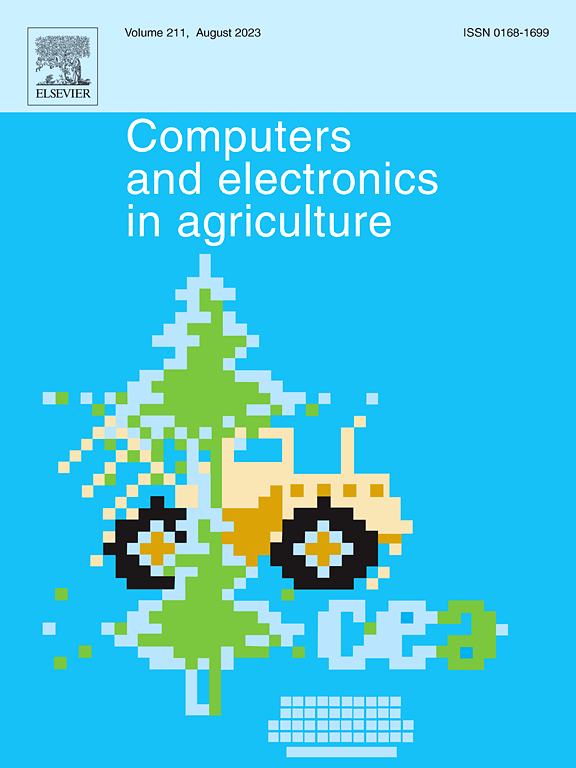高光谱成像VIS-NIR和SWIR融合改进草莓植株干旱胁迫鉴定
IF 8.9
1区 农林科学
Q1 AGRICULTURE, MULTIDISCIPLINARY
引用次数: 0
摘要
在可见-近红外(VIS-NIR)和短波红外(SWIR)光谱区域工作的高光谱成像系统越来越被认为是加强作物管理的实用和有效的工具。然而,当聚焦于特定的光谱范围时,高光谱系统可能有一些局限性,特别是在空间和光谱分辨率方面。结合不同传感器信息的图像融合技术对高光谱数据进行增强,可以显著提高空间和光谱分辨率。来自两个HSI相机(VIS-NIR和SWIR)的图像和光谱数据的融合数据提供了在可见植物胁迫症状之前植物生理、生物化学和形态的补充信息。本研究介绍了利用VIS-NIR (397-1003 nm)和SWIR (894-2504 nm)两种线扫描传感器实现高光谱图像融合的进展,以检测草莓植株的无症状干旱胁迫。基于特征和强度对两种高光谱成像系统的图像进行对齐,并结合各种几何变换进行融合。由此产生的融合高光谱立方体包含403个波段,覆盖397至2500 nm的广谱。鉴于草莓植物对干旱的脆弱性会显著影响其生长和产量,本研究旨在探索高光谱图像融合在干旱胁迫草莓植物高通量检测中的潜力。与独立生成的模型相比,融合图像提高了PLS-DA检测模型的性能,将分类精度提高了10%,在预测集中达到99%的准确率,并降低了错误率。本文章由计算机程序翻译,如有差异,请以英文原文为准。

Hyperspectral imaging VIS-NIR and SWIR fusion for improved drought-stress identification of strawberry plants
Hyperspectral imaging systems that operate in the visible-near infrared (VIS-NIR) and short-wave infrared (SWIR) spectral regions are increasingly recognized as practical and effective tools for enhancing crop management. However, hyperspectral systems can have some limitations when focusing on specific spectral ranges, particularly for spatial and spectral resolution. Image fusion techniques combining information from different sensors to enhance hyperspectral data can significantly improve spatial and spectral resolution. Fusion data of image and spectral data from the two HSI cameras (VIS-NIR and SWIR) provide complementary information on plant physiology, biochemistry, and morphology before visible plant stress symptoms. This study presents advancements in hyperspectral image fusion achieved by using two line-scan sensors, one for VIS-NIR (397–1003 nm) and the other for SWIR (894–2504 nm), to detect asymptomatic drought stress in strawberry plants. The images from both hyperspectral imaging systems were aligned based on feature and intensity, combined with various geometric transformations for fusion. The resulting fused hyperspectral cube contained 403 bands covering a broad spectrum from 397 to 2500 nm. Given the vulnerability of strawberry plants to drought, which can significantly affect growth and yield, this study aimed to explore the potential of hyperspectral image fusion for high-throughput detection of drought-stressed strawberry plants. The fused images improved the performance of the PLS-DA detection model, increasing classification accuracy by up to 10 %, achieving 99 % accuracy in the prediction set, and reducing error rates compared to independently generated models.
求助全文
通过发布文献求助,成功后即可免费获取论文全文。
去求助
来源期刊

Computers and Electronics in Agriculture
工程技术-计算机:跨学科应用
CiteScore
15.30
自引率
14.50%
发文量
800
审稿时长
62 days
期刊介绍:
Computers and Electronics in Agriculture provides international coverage of advancements in computer hardware, software, electronic instrumentation, and control systems applied to agricultural challenges. Encompassing agronomy, horticulture, forestry, aquaculture, and animal farming, the journal publishes original papers, reviews, and applications notes. It explores the use of computers and electronics in plant or animal agricultural production, covering topics like agricultural soils, water, pests, controlled environments, and waste. The scope extends to on-farm post-harvest operations and relevant technologies, including artificial intelligence, sensors, machine vision, robotics, networking, and simulation modeling. Its companion journal, Smart Agricultural Technology, continues the focus on smart applications in production agriculture.
 求助内容:
求助内容: 应助结果提醒方式:
应助结果提醒方式:


